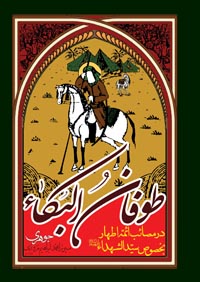Toofan Al-Boka fi Maqatel al-Shohada
Toofan Al-Boka fi Maqatel al-Shohada (طوفانُ البُكاء فی مَقاتِلِ الشُّهَداء) is one of the most famous Maqtal books among the people, written by Ibrahim bin Mohammad Baqir Heravi (1253 AD), known as Johari which was written by order of Haji Mohammad Saleh and Agha Saleh Khanban in 1250 AD and presented to Fath-Ali Shah.[1] This book narrates Ta'ziya and stories related to Ashura Event in an illustrated form.
 | |
| Author | Johari |
|---|---|
| Original title | طوفانُ البُكاء فی مَقاتِلِ الشُّهَداء |
| Language | Farsi |
| Subject | Maqtal |
About the authorEdit
Ibrahim bin Mohammad Baqir Heravi is famous as Johari, a poet of elegy and a native of Qazvin, whose date of birth is unknown, but he died in Isfahan in 1253 AD. Mohammad Baqir is his father's name, which is mentioned in some Tezkires as Ibrahim's name. In the book's introduction, Johari said his father's name as Mohammad Baqir Marvazi. He learned science and literature from Abdullah Khan Shahab Tarshizi in Herat. Due to the incompatibility of the conditions at that time, he emigrated from his homeland and came to Qazvin. Hence, some people considered him to be from Qazvin.[2] Johari died in Isfahan and was buried in Abchakhshan, one of the districts of Bidabad. Bahr-al-Tavil and Toofan Al-Boka can be mentioned in their works.
About the bookEdit
Toofan Al-Boka is one of the most famous Persian Maqtals in the 13th and 14th AD centuries, which is also known as Johari and is based on fluent prose and rhythm. This book has been the focus of Ahl al-Bayt reciters and preachers for many years. Toofan Al-Boka is about the life of the Prophet Mohammad, his daughter Fatima and Shia imams based on hadiths and narrations, and it is a combination of verse and prose. The book mentioned above was considered one of the main lessons in different parts of Iran in the past two centuries in traditional schools, and many Ahl al-Bayt preachers have benefited from it. Most likely, the authoring of this book was completed between 1245 and 1247 AH, and it was published for the first time in a written form, and with the widespread use of lead and stone printing in Iran, it was published in large numbers. There are 27 manuscripts and 17 lithographs of this book. The oldest stone print dates back to 1250 AD.[1] The lithographic copies of Toofan Al-Boka, published in 1260 AH, are available in the Vaziri Yazd Library and Museum and the Library, Museum and Document Center of the Islamic Consultative Assembly. Manuscripts of the book are available in the libraries of Astan Quds Razavi and the University of Dhaka, Bangladesh. The electronic manuscript is also available in Kashif Al-Ghita Library, which can be downloaded. From 1326 to 1390 SH, the publishers dealt with Toofan Al-Boka purely from a commercial point of view and without specialization. Mostafa Lal Shatari has, for the first time, presented a coherent and complete review of Toofan Al-Boka by examining available authentic manuscripts, lead and stone prints in 1390 SH. Toofan Al-Boka consists of twelve chapters, in which the sufferings of the Prophet, Faṭima al-Zahra and Shia imams are discussed with an emphasis on Imam Hussain.[3]
Book AbstractEdit
Toofan Al-Boka has 437 pages, including an introduction and fourteen fire temples (chapters). Each fire temple is divided into several flames (sections); at the end of each section are pictures related to the content. The longest and most detailed of them is the fifth fire temple, consisting of forty flames, about the life and martyrdom of Imam Hussain. In this book, except for the seventh fire temple, which deals with the rebellion of Mukhtar, Ahmad bin Safah Bani Abbas and Amir Timur Gorkani, the rest of the fire temples are dedicated to The Fourteen Infallibles. In the book's introduction, the author introduces each fire temple and states that each fire temple is related to which Infallibles. At the end of the fire temples, he also wrote a report about his situation in Qazvin. In the introduction, Johari also composed fourteen stanzas for Imam Hussain's Ta'ziya.
The value and importance of the bookEdit
One of the characteristics of Toofan Al-Boka is the use of a simple, fluent language and a stylistic device such as Bara'at and Istihlal (One of the stylistic devices in which the speaker or author writes the beginning of the poem in such a way that a preface of the main content of the poem is included in it). Still, some of its contents have been criticized for not having a source.
SourcesEdit
- Johari, Toofan Al-Boka
- The Great Islamic Encyclopedia